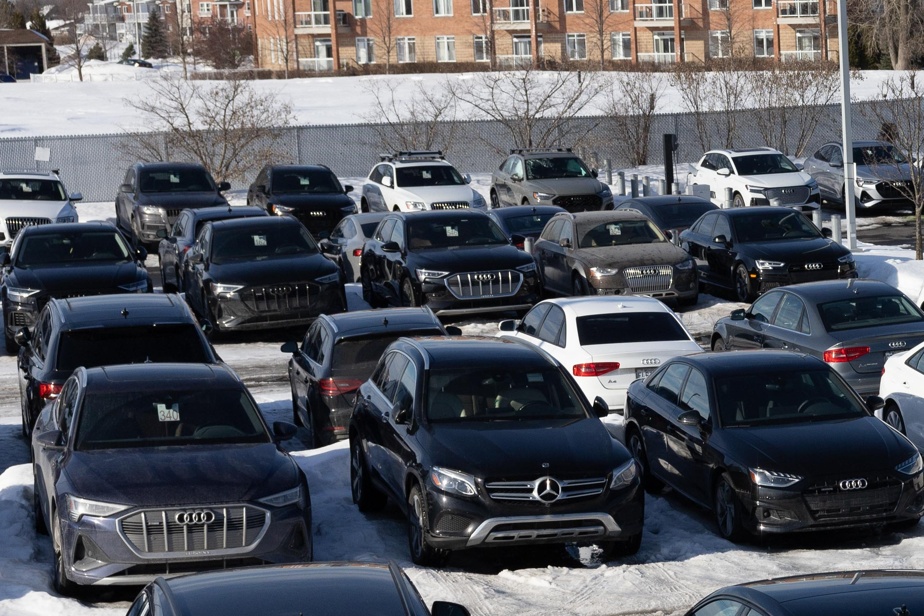Accustomed to stock shortages, car dealers are reconnecting with a certain rebalancing. But do they want to go back to the days when unsold vehicles sometimes piled up outside? In the industry, we are aiming for a happy medium: to have more than at present, but not as much as before the arrival of COVID-19.
For retailers, there are financing costs to bear when all the warehouse spaces are occupied. This bill is sometimes very high, especially when interest rates are on the rise – as is currently the case –, summarizes Pascal Ste-Marie, owner of Viau Ford in Saint-Rémi and vice-president of the Association. Quebec of the manufacturer’s dealers.
“In quieter years with fuller grounds, that could add up to $500,000 in additional fixed costs in some places,” he says. Often, it’s the difference between making money and not making money. »

PHOTO MARTIN CHAMBERLAND, ARCHIVES LA PRESSE
Pascal Ste-Marie owns Viau Ford in Saint-Rémi.
Dealerships’ ways of doing things have been disrupted by the health crisis, which has caused shortages of electronic components and production interruptions for car manufacturers. Some brands have been affected more than others.
In many cases, custom orders and long lead times had become the norm. This is still the case according to the brands and models.
“For the dealers, we had no interest to pay, explains Jean-Claude Gravel, president of Groupe Gravel. The cars arrived and were immediately delivered. It was different than having inventory in the yard and interest to be paid every month. There was a saving there. »

PHOTO MARTIN TREMBLAY, THE PRESS
At Groupe Park Avenue, inventories are around 60% of fall 2019 levels, before the health crisis.
In to have more
Owner of a network of four dealerships on the island of Montreal that offers brands such as Toyota, Acura, Honda and Cadillac, Mr. Gravel estimates that there are, on average, 20 to 25 vehicles offered in each of the outlets. of sale.
“It’s not euphoria, but it’s better than before,” he said.
Like many competitors, the businessman would like to reconnect with a certain balance.
When you have 30 to 45 days of stock in the yard, which can represent sales for a month and a half, this is the ideal situation. When this level reaches five or six months, it is not interesting.
Jean-Claude Gravel, President of the Gravel Group
Slowly but surely, the situation seems to be improving in the automotive industry for gasoline vehicles. For everything electrical, demand continues to outstrip supply. In a study published last January, Laura Gu of Scotiabank pointed out that production rebounded among builders last year from lows in 2021.

However, the pace slowed in the last three months of 2022. As a result, North American industry is still at 15% of its pre-pandemic production level.
“The Ward Automotive Group estimates that the production […] expected to grow 7% in 2023 to 15.2 million units, writes Mme Gu. However, this will remain well below the 16.2 million vehicles built in 2019.”
happy medium
At Groupe Park Avenue, the picture is improving, according to Norman John Hébert, recently appointed president and CEO of the family business. In the network of 16 dealers spread over the South Shore, Montreal, Quebec and Sherbrooke, inventories are at around 60% of the levels of fall 2019, before the health crisis.
But the situation varies from one manufacturer to another. By offering 14 brands in his network, Mr. Hébert is well placed to see this.

PHOTO MARTIN TREMBLAY, THE PRESS
Norman John Hébert, President and CEO of Groupe Park Avenue
“On the Toyota side, there is zero inventory,” he said. We deliver between 60 and 80 vehicles per month, but everything that is delivered is sold in advance. We would like to return to a level of 45-60 days of stock at our dealerships. Before the pandemic, for some American and Korean brands, there was up to 200 days of stock. It wasn’t healthy. »
The Corporation of Quebec Automobile Dealers (CCAQ), which has more than 890 members, also observes a lot of “fluctuations” from one manufacturer to another in terms of supply. Its chairman and chief executive, Ian Sim Ye Chi, also anticipates a balance in retailer inventory.
This question has an economic dimension and a competition issue.
There is a direct financial cost if there is less need to fund inventory, let’s be honest and transparent. But the market is very competitive. If you don’t have a product to meet the consumer’s needs within a reasonable time, you end up losing sales. I think there is a certain balance to be struck between inventory and the ordering system.
Ian Sim Ye Chi, President and CEO of the Corporation of Quebec Automobile Dealers
The owner of Groupe Gravel agrees. It’s important to remember, he says, that salespeople get paid when the sale occurs. At the heart of the pandemic, some were waiting “several months” before receiving their commission.
In addition, adds Mr. Gravel, not all consumers plan a change of vehicle months in advance. You have to be able to meet the pressing needs of customers.
“Someone who has to put several thousand dollars on his car may decide to change,” explains the businessman. Suddenly, the latter becomes a potential customer. He doesn’t feel like paying for repairs and then shopping for a new car. We have to be able to offer them something. »
Despite the rise in interest rates and fears of recession, demand for new vehicles does not seem to want to run out of steam. The offer “has not yet reached the level of demand”, says the President and CEO of the CCAQ. It remains to be seen whether the inflection point will be reached more quickly than expected if the economic context deteriorates.
Learn more
-
- 103,771
- Number of new vehicles sold in Canada in February. This is an increase of 5.1% compared to the same period in 2022.
Source: DesRosiers Automotive Consultants
